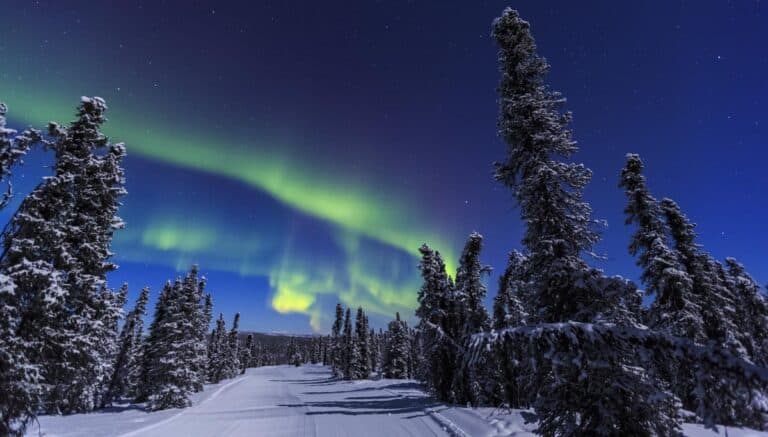
Editor’s Note: Travel is complicated right now. Please check local regulations and location openings before you go. We share places, products and activities we recommend. If you make a purchase using a link on our site, we may earn a commission.
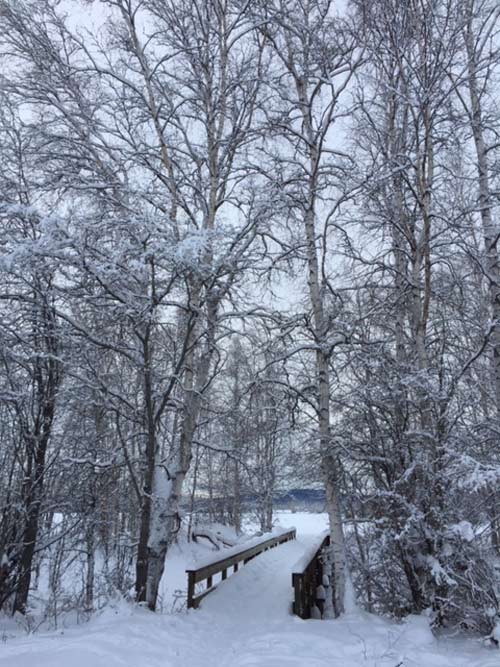
Winter in Fairbanks
“Is it really true your hair can break off?”
I smile at this question from a fellow visitor to Alaska’s legendary Chena Hot Springs, a geothermal resort an hour outside Fairbanks. The issue arises because our corporeal cores are relaxing in 104-degree mineral water—but our heads are outside in midwinter frigid air. I do mean frigid: 15 below, Fahrenheit.
All that hot water makes vapor which condenses into the nearest absorptive material, in this case, human hair, and thereafter freezes. Mine is short enough it won’t break off under any circumstance; hers is much longer and plated around her head like rime tentacles. So it’s a reasonable question.

I tell her the answer’s no. Even frozen, hair still flexes.
“You’re sure?” she replies.
Yes, I am. I’ve been here many times, and am fond of proselytizing the virtues of Interior Alaska in the dead of winter. Aside from soaking in hot springs while the weather is far below zero, Fairbanks offers a wide array of winter experiences nearly impossible to duplicate anywhere else.
There is, first and foremost, cold. “It’s a dry cold, though,” residents invariably explain. Midwinter humidity generally runs 50-60 percent, and the more accurate measure of temperature discomfort, dew point, is breathtakingly low… 10-30 degrees below zero. There’s very little wind.
Fairbanksians happily venture outdoors down to -35°F or so, and every resident proudly cherishes their all-time low: -64°F for my friend Amy, who’s been here decades.
So, bundle up and pose for a picture beside the local university’s outside thermometer. See if any of your family and friends can prove they were outdoors at -32°F.
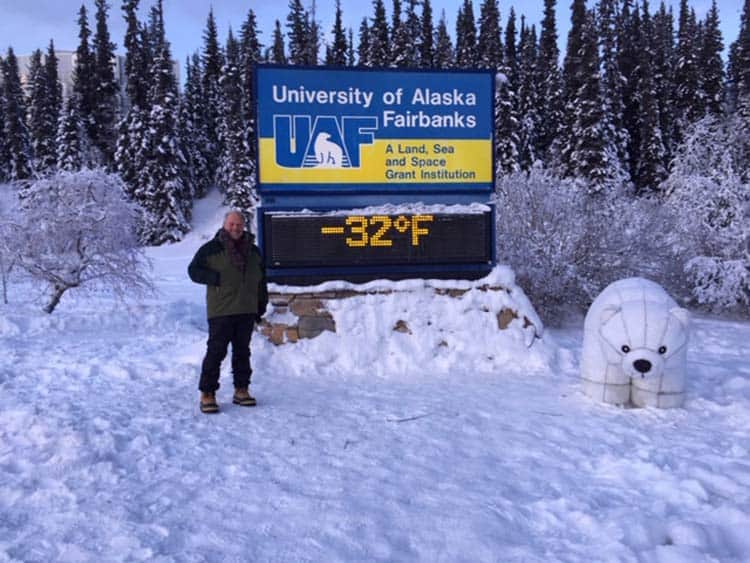
Find a Hotel or Airbnb in Fairbanks
Frontier Living
A growing number of visitors come to Fairbanks in the depth of winter specifically seeking colossal cold, such as the -54°F a few years back. But that’s mercenary travel, as if some arbitrary mercury density could capture the ethereal essence of the Northland.
I prefer the tangy scent of lodgepole pine and black spruce, and the ivory light of birch woods, both of which I experienced earlier that day snowshoeing along a ridge northwest of the city.
I’m not a big fan of this sport, which is like dragging wet boots through shag carpet—but at 30 below, one doesn’t stay out long anyhow. We looped through the woods about a quarter-mile, then repaired to LeafOutAK guides Evan Sterling and Shannon Busby’s cabin for chaga tea and shortbread cookies.
“How do we live without indoor plumbing?” Shannon says most visitors ask once they’re back inside the couple’s one-room “dry cabin,” an icon of Alaska life. “The answer is, patiently.” She laughs. Alaska Chicks Are Tough, says a famous Last Frontier T-shirt. Anyone can buy such a shirt, but it’s a bit fatuous unless you’ve experienced the essence of the lifestyle—such as using an outhouse at 30 below, or in a swarm of mosquitos in midsummer.
Most visitors are little interested in discomfort, which is why local adventure entrepreneur Reini Neuhauser invented his ice-fishing/Northern Lights tour, bringing groups of travelers to Chena Lakes for an evening of salmon catching and aurora viewing. Inside the fishing shack, you can perch comfortably on the benches and jig through three feet of ice for 12-inch kokanee (landlocked) salmon.
That’s dinner, which Reini fries up on the woodstove, another icon of Last Frontier life whose virtues are limitless: toasty warmth, comforting crackle, flickering fire and cooktop utility.
When the lights paint the sky—which happens just about every night up here—folks dash outside to aim cameras at the vivid green, tangerine and vermilion banners shimmering overhead northeasterly.
It is a sight unlike any else on Earth, and avid photo bugs devote incessant 10-minute episodes attempting to catch the perfect image. Armed with lenses bigger than chainsaws, some will stay up all night waiting for nature to perform.
Personally, I think my picture-memory is perfect, and almost any natural phenomenon is perfect too; both ideas require just a few minutes of gazing. Back in the fishing shack, the salmon are tender and moist, the pan-roasted potatoes are redolent, the temperature is a balmy 45, and I’m relishing the chance at wintertime angling without ice-blue fingertips.
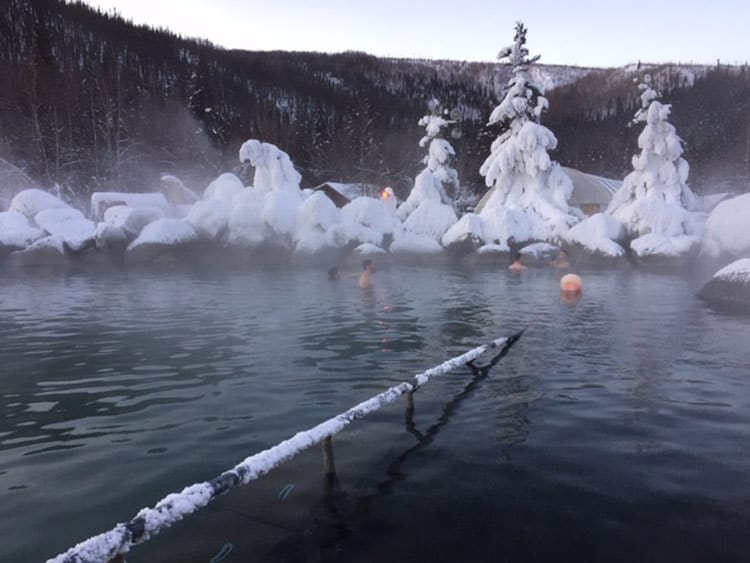
Warming Up Fairbanks
The next day I venture out for another midwinter amazement, fat-tire biking. These are mountain bikes with immense, nubby tires that ride snow like dune buggies. Sound hard? It’s actually easier than piloting a regular off-pavement bike, and the weather has moderated to near zero.
In the bright sun, riding through the bare-branch cottonwood and birch forests in Fairbanks’s marvelous, huge park, Creamers Field, I’m so warm that I have to shed the thick outer sub-Arctic layer I had donned that morning and unzip my inner parka as well.
“It’s always like this,” my guide, Jeff Gilmore, tells me—and laughs uproariously because, of course, it’s not. Fairbanks outdoors-people believe they invented these bikes right here in 1996, and they use them for mind-boggling adventures such as 100-mile one-day races over the White Mountains northeast of the city. Thirty below, no problem. The steep slopes keep you warm.
I’m content simply to pass through snowy woods with ice crystals sparkling in low-angle sunrays, and bask in the solar warmth provided free by the star that makes all this possible, including the aurora.
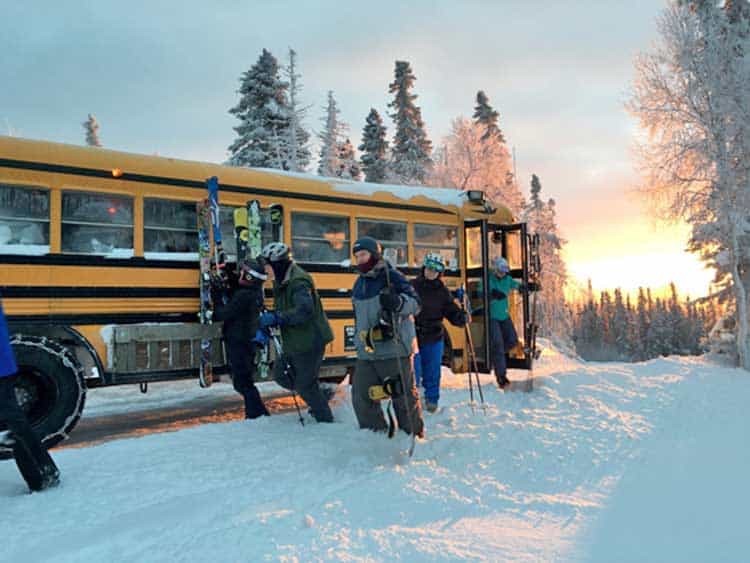
I’m not the only cold-weather pussywillow in town. Next day, downhill skiing at Moose Mountain, a low rise east of downtown Fairbanks, I am introduced to a local tradition so deliriously popular that suggestions about replacing it are roundly derided. There are no ski lifts at this old-school, 1300-foot vertical, 20-run area.
Instead, skiers clamber aboard venerable school buses at the base for a 10-minute chug back uphill. The Moose, as it’s known, calls these conveyances “variable capacity turbo-charged terrestrial trams,” and no one minds at all that they are “turbo-charging” uphill at about 10mph.
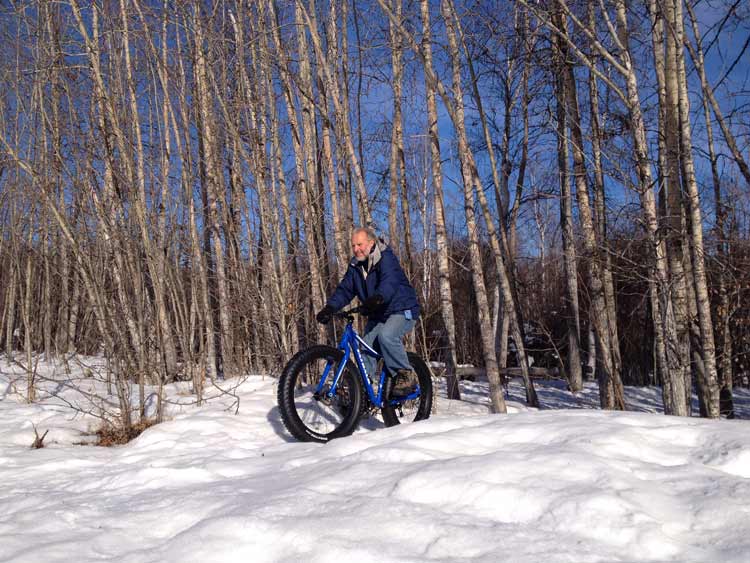
Outside, it’s -20°F. Inside, it’s 50°F. In other words, it’s a fully heated rectangular yellow gondola on wheels. Better than some actual gondolas at high-octane resorts. “Slow down,” someone yells at the driver downshifting around a turn. “We’re not in a hurry.” We all peel off gloves and caps and sit back gratefully.
In the Alaska Interior in winter, time travels tenderly by.
If You Go
Find tours and expert guides to explore Fairbanks from biking to seeing the Northern Lights through GetYourGuide. Check out all of their activities and guides here.
Get a hotel in Fairbanks that meets everything you need for the best price here. If you’re looking for more of a home away from home experience, then check out these home rentals for a more secluded stay in Fairbanks here.
Author’s Bio: Eric Lucas is the author of the Michelin guide to Alaska and former associate editor at Alaska Airlines Magazine. He lives on a small farm on San Juan Island, where he grows organic garlic, beans, apples and hay.
- Exploring the Culture and History in Fascinating Astana, Kazakhstan - July 24, 2024
- Breakers & Beyond: Top 10 Things To Do in Newport, Rhode Island - July 23, 2024
- Laid-Back Lombok: Coconut, Coffee and Coral Reefs - July 22, 2024
